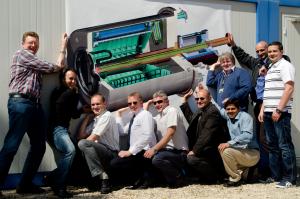Ready to hand over to industry
20 Apr 2012
This model of an ITER cryopump that the vacuum team appears to be hauling out of Building 525 represents many years of development, which were recently finalized at ITER.
The "built to print" design of this eight-tonne component (shown here at 2:3 scale) requires no less than 250 technical drawings to enable it to be manufactured to the precise standards required for the ITER Tokamak.
Detailing the design down to the smallest bolt was essential for this high-performance component to fulfil its demanding functions on ITER. The vacuum team is celebrating its completion.
Tender actions by both ITER Organization and the European Domestic Agency, Fusion For Energy, have been issued for the manufacturing of the first full-size cryopumps, which will be assembled by industry and tested at the Karlsruhe Institute of Technology in Germany.
"Cryopumps are among the most complex of ITER components," say both Vacuum Section Head Robert Pearce and Matthias Dremel, who led the final design phase. "These pumps are unique. They contain the world's largest all-metal high vacuum valve and operate with 4.5 K (minus 268.5 °C) cryogens in the harsh environment of the heart of the ITER machine."
After creating a high vacuum inside the Tokamak chamber, six torus cryopumps will have the responsibility of taking impurities and the helium ash out of the plasma, thus enabling ITER to sustain its full performance.
Two more cryopumps will be installed on the cryostat to maintain the low pressure required for the operation of the magnets.


